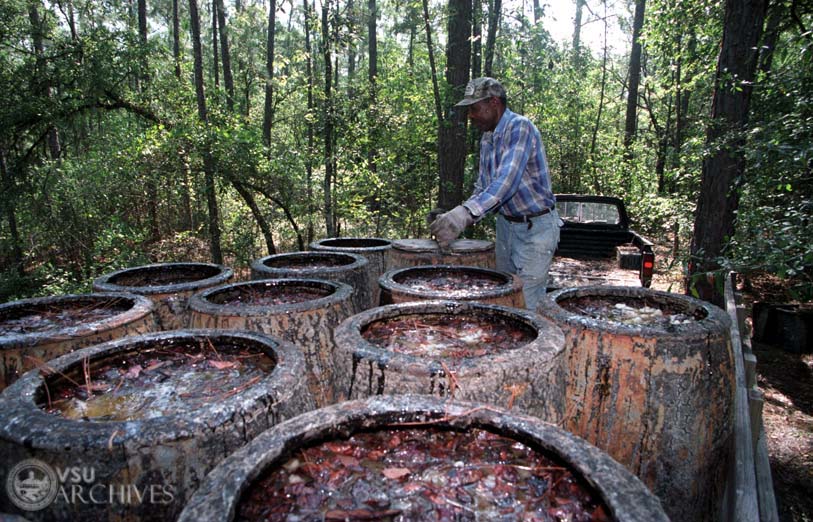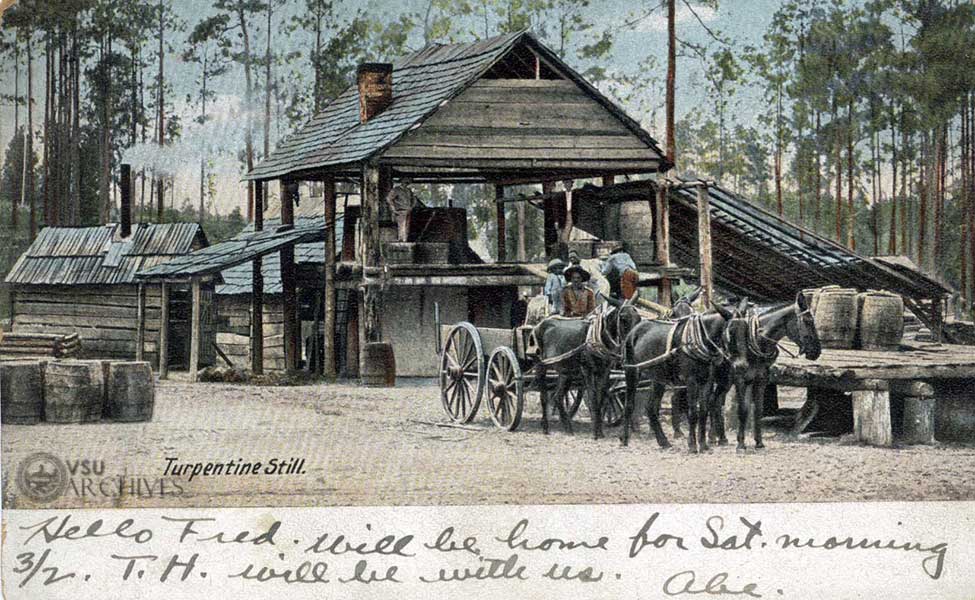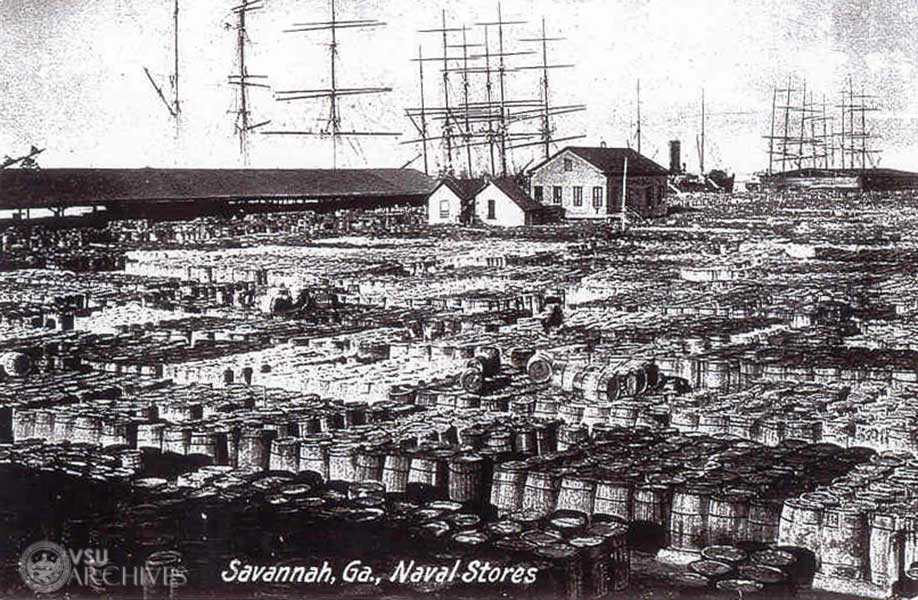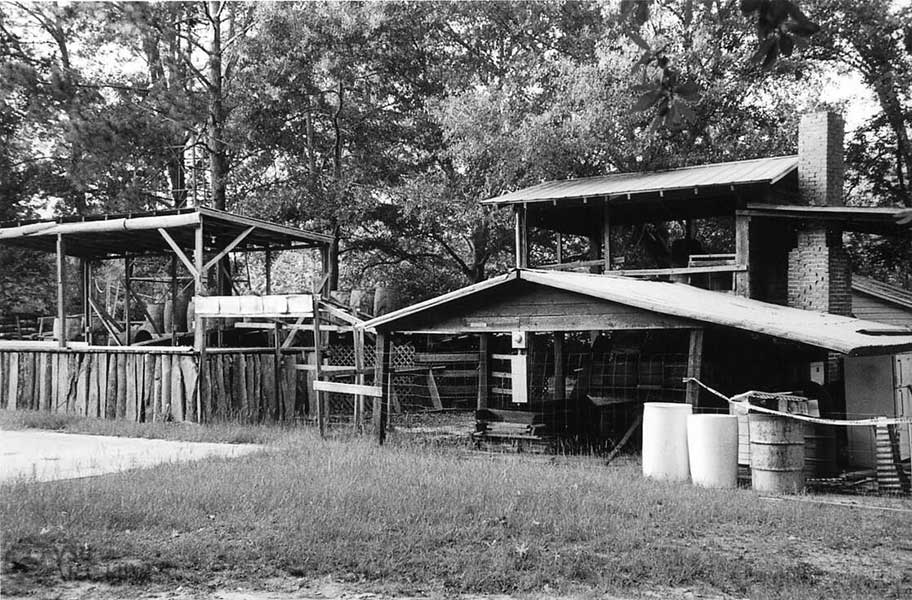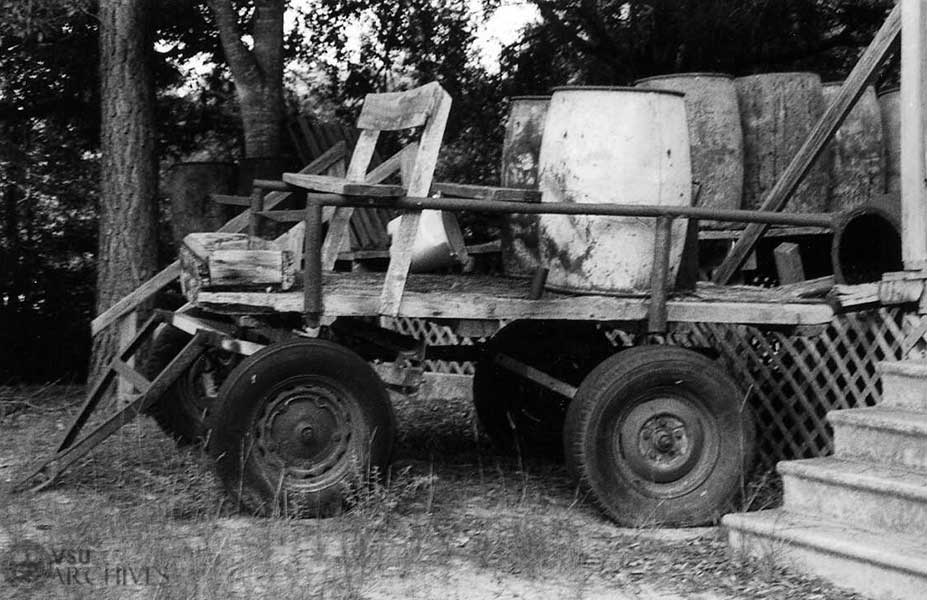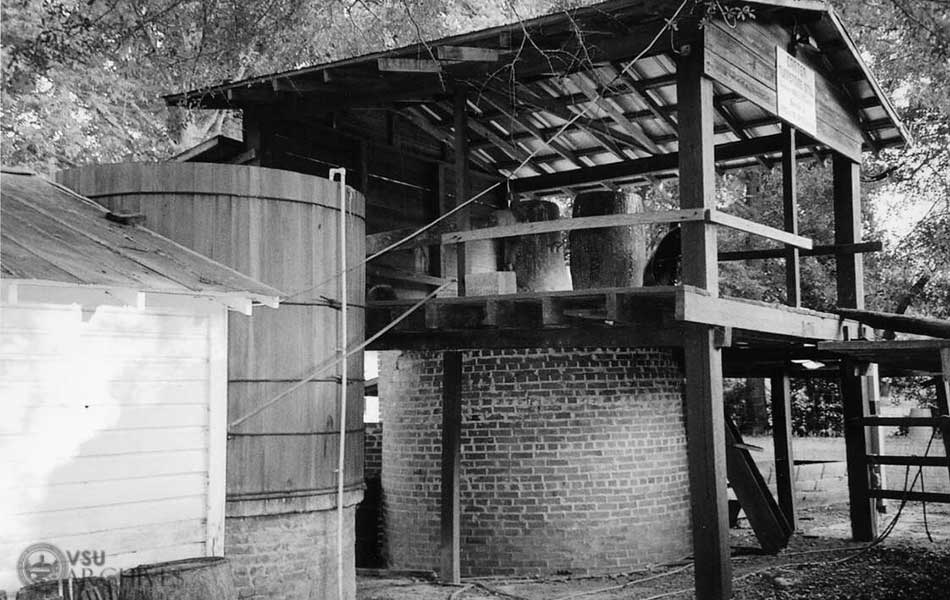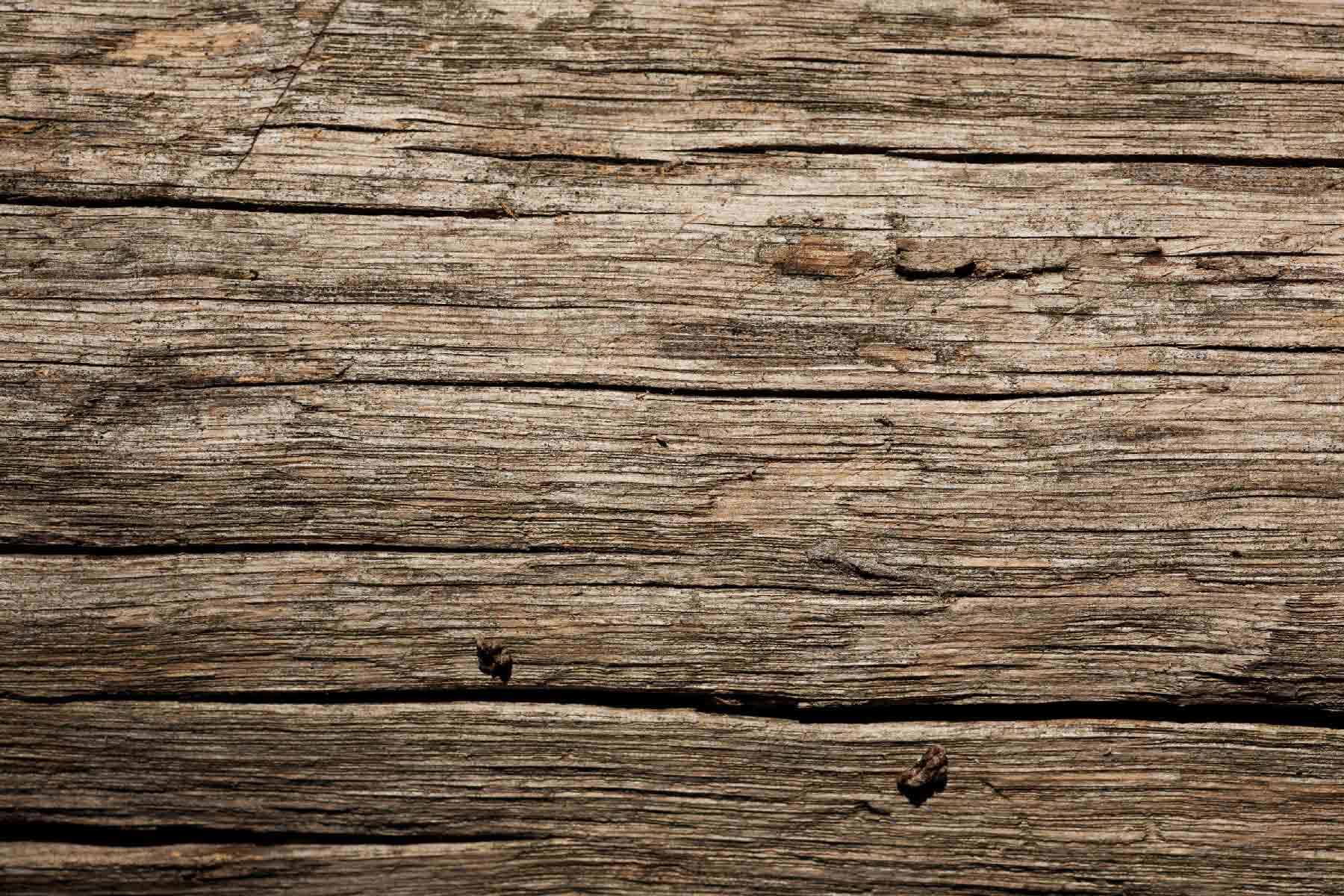

Faces in the Piney Woods
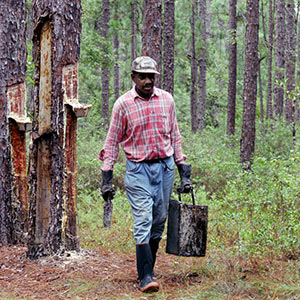
Faces in the Piney Woods: Traditions of Turpentining in South Georgia is an oral history project of the South Georgia Folklife Project at Valdosta State University. It is developed from the perspective of the field of folklore and focuses on the occupational folklife of South Georgia turpentine workers. For much of the past century, Georgia was the nation's leading producer of gum naval stores, or the industry of extracting products such as turpentine and rosin from living pine trees. The last bucket of gum for commercial turpentine was dipped in the summer of 2001 in Treutlen County, Georgia. The end of domestic turpentining in the U.S. inspired the project team to interview former turpentine workers about their lives and traditions. The work of gathering and processing the raw gum was done chiefly by African American men, although countless European American small gum farmers turpentined on their own land or on land leased from others. These workers developed specialized knowledge, terminology, customs, and lore which folklorists call "occupational folklife." This site contains information gathered from 1998-2004 through background research, photographs, video, and oral interviews. It includes information on work in the woods and life in the turpentine camps told as told by those who lived it.

Major Phillips dips the last buckets of commercial turpentine in the United States for Soperton (Georgia) Naval Stores, August 9, 2001. Photo by Bill Godfrey courtesy Georgia Forestry Magazine.
Faces in the Piney Woods Final Fieldwork Report
Prepared for Georgia Council for the Arts Folklife Program Grant FY04-41-271
Timothy Prizer, author
Dr. Laurie Sommers, Introduction and editor
South Georgia Folklife Project, Valdosta State University, 2004
Part One: Introduction page 1.
Part Two: Meet the Inteviewees page 7.
Part Three: In the Woods page 19.
- Them Jokers Could Work
- The Boss Men
- Diversions in the Woods
- It Just Sounded Lika Song, All Day Long
- The Turpentine Mule and the Pickup Truck
- Knowledge, Innovation, and Coping with Danger
- Nature's Best Medicine: Pure Turpentine
Part Four: The Camp. The Community. page 53.
- Living Quarters in the Camp
- "From the Womb to the Tomb:" Commissary and Camp Life
- Joikin, Drinkin, and No Blue Lights Flashin
- Women and Domestic Life
- Beneath the Steeple
- Children and Schooling
Part Five: The Spirits of Turpentine, A Conclusion page 75.
Part Six: Literature Cited page 82
Full Report
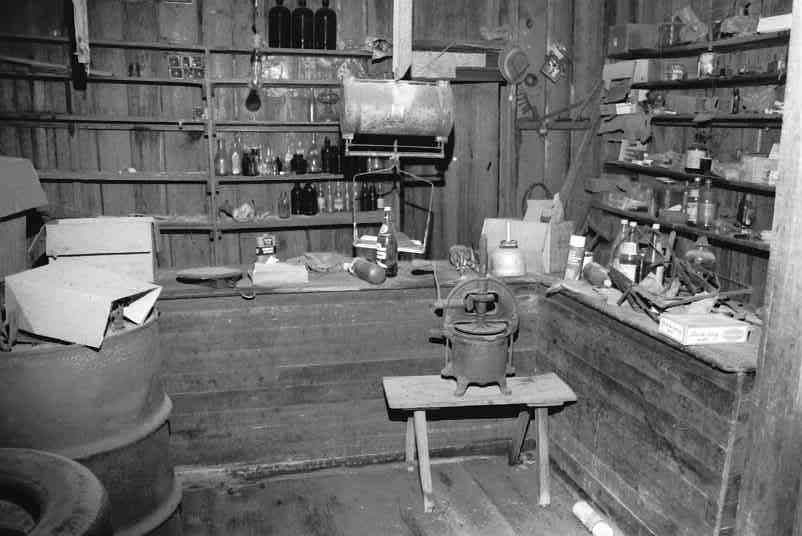
"Faces" of the Piney Woods: List of Project Interviews
Brockington Wetherington, Patricia
Interview Transcript
Born in 1935 in rural Clinch County, Pat Brockinton still lives on the site of Dayton Turpentine Camp outside Fargo which she and her first husband, Robert Wetherington, took over from her father-in-law in 1955. The property has its original commissary, woods rider's home, and turpentine quarters, disintegrating reminders of the business which the Wetherington's closed in 1975. Although this project did not emphasize the experiences of turpentine owners and operators, Brockinton's story provides an interesting perspective on the role of a wife in a family turpentine operation. In addition to the traditional woman's role of child rearing, cooking, and keeping house, Pat worked in a variety of ways in the Wetherington turpentine operation. Much of this revolved around the commissary, which she would open for the hands when they needed something, and in care of the workers. The latter included driving them to doctors' appointments, fixing plates of food dispensed at Christmas and New Year's, and providing medical care and advice. In the medical arena she was perhaps atypical: Pat had skill in both traditional medicine and through a nurse's aid certificate. She also assisted her husband in the yearly wintertime burn, and, for three years, in driving the truck to deliver barrels of gum to the Langdale still in Valdosta. Pat's first husband died in 1992. She married Ray Brockinton in 1996.
Carter, Gillis
Interview Transcript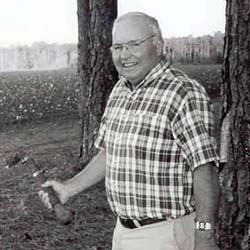
Born May 1, 1941 in Coffee County, Georgia, Gillis Carter spent the earliest years of his life as young boy whose father, Era Carter, was on the verge of becoming successful in the turpentine business. By the time Gillis was five years old, he lived in a house just a short walk from his current home on the outskirts of Willacoochee, and his father had begun hiring a fair number of African American turpentine hands to work the timber on land he leased from others. Under their father, Carter and his four brothers grew up working turpentine, and the only break Gillis would take from that line of work was the four years he spent acquiring his B. S. in Chemistry at the University of Georgia. He worked turpentine and hired countless others to work for him until 1978, when his father recognized that turpentine would no longer turn the profits it once had. Though the turpentine industry has vanished from the country, and though his primary human link to it - his father - has passed away, Carter remains more actively involved in the memory of the work than perhaps anyone in the United States. He continues to work four trees and six faces in his front yard, and one of his barns houses an elaborate collection of turpentine tools and artifacts. His goal is to remind those who may have forgotten about the industry and to educate the younger generation that may not otherwise ever learn to appreciate the livelihood of its forebears. Carter lives now with his wife and his mother-in-law in Willacoochee, and his children and "grandbabies" live on the property adjacent to his.
See Also: Tools and Techniques
Green Jr., Anthrom
Interview Transcript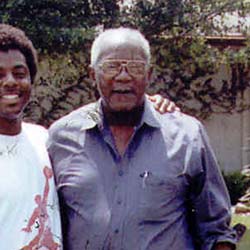
Anthrom Green Jr. was born in Soperton, Georgia on October 27, 1918 on the Gillis Plantation. He came to Jacksonville, Florida in 1938 and has lived there since that time. Although he grew up around turpentine camps, young Green was introduced to the business of turpentining at age 17 by his father, Anthrom Green Sr.; he and his father worked side by side. Anthrom, Sr. also hired out his son to work on various farms. The Green family lived across the street from a still in superior housing for African Americans of the time, due to the fact that Green's mother carried the Gillis name via slavery. As a young man Green worked various jobs in the turpentine woods, and he has vivid recollections of camp conditions, camp diets, entertainment, schooling and church, share-cropping and payment, the house that he grew up in, and the treatment of workers in different camps. Green left turpentining in 1938 and never returned.
Harrington, George
Transcript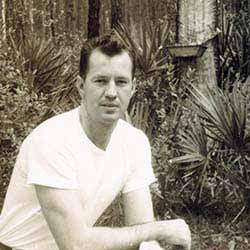
George "G.W." Harrington, born 1932, grew up in various south Georgia turpentine camps, first 8 Mile Still outside Homerville, then Fodie Camp outside Morven, and finally Greenwood Camp outside Stockton where, from 1941-1960, his father JW "Jake" Harrington, Sr. managed the 16,000 acre tract owned by the Southern Resin and Chemical Company of Philadelphia. The elder Harrington had worked turpentine as early as the 1920s and retired in 1960 when the labor grew unreliable. G.W. started dippingin 1943. Later he rode woods and with his father took care of the horses and mules, and did various jobs through 1950. Harrington is unusual in that he has photos taken by his brother-in-law, Joseph O. Rodgers, which show not only woods work and the family home, but also a rare interior photo of the camp commissary. His father would order stock for the commissary, but his mother held "grocery time" or "grocery night" for the hands. After a stint in the military and a year as an outfielder in the old Georgia-Florida minor leagues, he went on to work for Coca-Cola. He is currently retired and living in Valdosta.
Johnson, Wilburt
Interview Transcript
Wilburt Johnson was born on June 26, 1921 in the small Atkinson County community of Kirkland, Georgia. By 1932, at the young age of eleven, Johnson had literally followed his father into the woods and demanded to begin chipping boxes alongside his old man. He caught on quickly, and he worked in the forest industries for the remainder of his working life. In turpentine, he worked under a man for a number of years in Middleton, Georgia before working for Era and Gillis Carter in Willacoochee. Outside of turpentine, Johnson long-logged and worked in the pulpwood industry for several years. He only quit the turpentine business when it became necessary for him to do so. The industry crossed the ocean and he crossed into old age. He spends most of his days now with his wife, his children, his grandchildren, and his great-grandchildren. Warm weather finds him in a rocking chair in his carport in Willacoochee, and he is remembered by all in the area for his memorable holler in the woods:"Can I Go?"
Music, George Jr.
Interview Transcript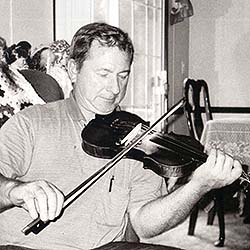
The only living member of his family that worked in the turpentine woods, Music was born in 1960 on the same piece of land where he currently resides on the rural outskirts of Waycross, Georgia. Music began working turpentine in 1967, when he chipped his first tree at the young age of seven. He used to follow his father, George Music, Sr., and grandfather around in the woods before he was old enough to do any real labor, and he would pretend to be working. Music says that he always wanted to be "just like daddy" when he was a boy. However, by the time he was 17 years old, he thought he had had enough of the hot and arduous labor involved in turpentine production. He headed off to get married, residing and working as an auto mechanic in Jamestown, Georgia. But "something always brings you back home," he says. "You just get to missing it." He returned to the massive expanse of timber at his home in Waycross after divorcing his first wife, and he is passionate about never leaving home again.
Music has only worked in turpentine on his own land and has never experienced life in a turpentine camp, a typical situation for many white, working class South Georgians. There are approximately three thousand trees on Music's land that were used for turpentine production. His grandfather Louis worked and lived on the same property even before the current Music home was built in the very early years of the 1900s. At any given time that he and his father were working in the woods, they kept in between 1,800-2,500 faces in production. George Music, Sr., however, supposedly once worked five thousand boxes at one time. Today, Music works as a locomotive mechanic and is a talented fiddle player and harmony vocalist in a local bluegrass band Tri-County.
Nelson, L.A. "Stick"
Interview Transcript
L.A. Nelson was born in Spring Hill, Georgia on February 26, 1903. Spring Hill was a settlement outside Thomasville, Georgia, started by African American migrants from South Carolina. They cleared a wooded area and established homestead farms on the cleared site. Nelson's biological father left the family while he was still quite young, but he and his younger sister were reared by his mother who worked several domestic jobs to provide for them. Nelson was introduced to the turpentine business by his stepfather, Mr. Will Brown, sometime between his twelfth and thirteenth birthday (1915-1916). His first experience in the woods was raking pine. Nelson's family moved from community to community in north Florida and South Georgia over a fifty year period, as Nelson worked in farming and in the woods. He held a variety of jobs in turpentining, including that of woods rider which was unusual for a black man at the time. His experience also put him in the employ of many different South Georgia turpentiners, among them Poole and Langdale, three generations of the Wetherington family, and S. W. Paul (sic). He met his wife, Bertha, when she was living on a neighboring turpentine camp. Nelson was interviewed for the project several months before his death at age 99 in January, 2004. He describes in great detail--sometimes humorous and sometimes painful-- his experiences over several decades as a turpentiner, including camp conditions, bosses, entertainment, sports, money, self employment, food, education, religion, women and children.
Phillips, Major
Interview Transcript
Major Phillips was born in 1945 in Treutlen County, Georgia, and has worked in the woods for most of his life. He dipped the last barrel of commercial turpentine in August, 2001, while in the employ of Jim Gillis, Jr. of Soperton Naval Stores. At the time of the industry's demise, Phillips had worked for the Gillis family for over 20 years and is still in their employ as of this writing. Phillips' father had worked the pine woods for over 40 years, and young Major began working beside him at age 12. His first job was dipping tar, and he states that he and his father could dip as many as 2000 trees per day. Phillips worked for a number of employers in the Soperton vicinity and beyond, including the Claxtons, the Phillips, and the Kennedys of Cobbtown, the latter an African American family that had its own farm, still and turpentine farm. Along with turpentine, he sharecropped cotton, worked in a sawmill, and also worked cotton and tobacco on his family farm.
Taylor, C.J.

C. J. Taylor, born approximately three years after Junior on the Mayday, Georgia, turpentine camp, began working turpentine as a barefooted ten-year-old, much like his brother. As they ventured together from camp to camp, Taylor worked in the woods alongside Junior for about forty years. Though Taylor enjoyed the work like most turpentiners, he did not have the willpower to stay in it as long as Junior did. C. J. did spend most of his life working turpentine, but he was also more prone to fleeing the camp to find a different line of work altogether. While most turpentiners avoided being drafted to war and found little threat of actually having to go, C. J. volunteered for the Korean War. The war lives on vividly in his memory, both as a rewarding and haunting recollection. It is clear from speaking with him that he considers his stint in the war the most significant event in his life. After working together for so long and surviving the turpentine industry's demise, C. J. and Junior remained extremely close until Junior's death. Their homes sat side-by-side in Blackshear, and they remained the closest of fishing buddies even in old age.
Taylor, Junior
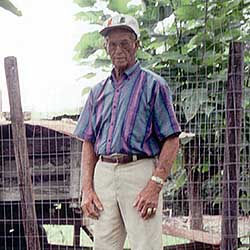
Junior Taylor was part of an extensive family of turpentiners. Nearly every relative in Taylor's memory, dead or alive, was involved in the production of turpentine in one fashion or another at some point in their lives. In fact, Taylor, his father, and all eight of his brothers were employed in turpentine. Junior was perhaps the most well-known worker in this long line of turpentiners, however, and he was a household name in the area of Blackshear, Georgia right up to his recent death on January 21, 2004. Taylor made his living on approximately twenty turpentine camps throughout South Georgia and Florida, the first of which was in Mayday, Georgia, in Echols County. Shortly after Taylor's birth on a farm in Alabama, his mother and father moved to Mayday, where he would live the first 10 years of his life, starting his work in turpentine as a shirtless, shoeless eight-year-old. Taylor worked turpentine for about sixty consecutive years and racked up his high tally of camps due to both his and his father's escaping commissary debt, harsh woods riders, and crooked producers. The largest camp Taylor remembered living in had about forty or fifty other workers residing within it. The Taylor name is locally famous, due largely to the family's gospel singing group. The Taylor Brothers, with which Junior sung occasionally but was never an active member, was popular among certain clusters of gospel fans throughout Georgia, Alabama, and Florida and had a regional hit in the late 1960s, "Mother's Advice." Singing kept the Taylor family together during some difficult circumstances. Now the Taylor's nephews and brother have their own group, the New Taylor Singers.
Tomlinson, W. C. "Dub."
Interview Transcript
The life of W.C. "Dub" Tomlinson (born 1931), recounted in his self-published memoir A Lad in the Piney Woods (2002), typifies the old-time Wiregrass lifestyle of farmer, rancher, and turpentiner during the period of the open range in South Georgia. A life-long resident of Echols County--with the exception of a stint in military service-- Tomlinson has worked timber all his life, first in turpentine, then a heavy equipment operator and harvesting supervisor. He also has been a cattle foreman; as he explains, even the cattle ranches had timber on them. Throughout it all he moonlighted on weekends with his band The Suwanee Troubadours, a traditional country group for which he was lead vocalist, and lead and rhythm guitar player. A gifted storyteller, Dub is particularly animated when talking about his experiences as a cowman, but his memoir includes many anecdotes about turpentine men. He started out as a youngster working 532 acres of family land with his father. The best use of the piney woods was to work the trees for naval stores, graze cattle and hogs in the woods, and raise livestock feed and fruits and vegetables on small subsistence farms. Tomlinson's father only worked turpentine steadily for a year and a half, but Dub went on to work in turpentine for other employers in the region, including the Langdales and Wetheringtons, rising to the rank of woods rider.
West, Elliott and Eddie Lee Scipp
Interview Transcript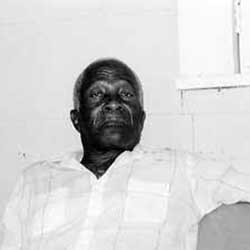
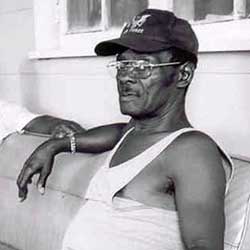
Elliott West (left), born August 27, 1920 in Darien, Georgia, has lived on countless turpentine camps since he was six years old. His father was employed on a camp in Brantley County when West was very small, and much of West's childhood was spent playing games with other children in South Georgia's and northern Florida's turpentine quarters. Having worked for over sixty years to harvest gum from pine trees, West knows little else when it comes to work. He remained active in the woods until economic factors ("They can buy it cheaper across the water," he says) removed turpentine from the area entirely just a few short years ago. His experience spans the era of turpentine quarters to the last years of turpentining in South Georgia, where he worked for Alton Carter until sidelined for health reasons. Carter and West were featured in the 1998 radio series, Wiregrass Ways, speaking about turpentine. West lives alone today in Folkston, Georgia, where he does landscaping for friends and neighbors. He remains friends with some former turpentiners in the area, especially Mr. Eddie Lee Scipp (right), whose name and comments appear in this report.
White, Willie
Interview 1 Interview 2 Transcript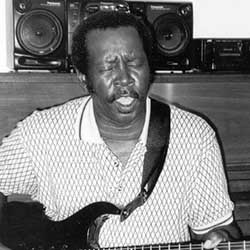
Willie "Coon" White, Jr. was born on March 21, 1948 in Hoboken, Georgia. White first entered the woods as a turpentine hand when still just a boy. His father taught him how to chip his first box, and before long, he was a member of what his first boss man (Frank Dukes) called the "Little Boys' Squad." The group consisted of seven or eight boys supervised by a woods rider who drove the boys around on a tractor while the youngsters dipped gum. When White was 16 years old, he graduated out of the "Little Boys' Squad," quit school, and began working turpentine fulltime. He remained in the woods for several years before getting hired by George Varn to work at the Varn Turpentine Still in Hoboken. After several years of work at the still, turpentine began to dry up as an industry in the United States. The pines, however, remained as much a part of the occupational framework as ever, and Willie White fell into his current job in the sawmill at Varn Wood Products, also in Hoboken. Today, White lives with his wife in Hoboken, where he is a preacher at a local Holiness church and a talented gospel singer and guitarist.
Wilcox, Bernice and Wilcox, J. F.
Interview Transcript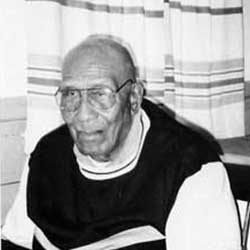
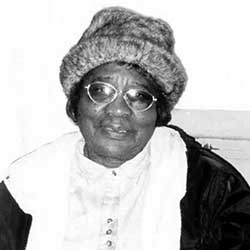
Married in the Ludowici, Georgia turpentine quarters in 1940 at the respective ages of nineteen and fourteen, J. F. and Bernice Wilcox were each also born on turpentine camps. J. F. was born on a camp in Tattnall County, Georgia on January 4, 1921, while Bernice entered the world on November 17, 1925 on the Jasper County, South Carolina turpentine camp where her father was employed. Though J.F. spent his early years in the confines of the camp, he moved to Ludowici as a six-year-old and would never live on a camp again. At age ten he began work in the woods as a turpentiner alongside his father. He learned to chip boxes the old way, cutting a cavity into the tree itself rather than tacking cups to the bark for the collection of pine gum. Mr. Wilcox would remain a turpentine hand until he turned seventeen and became a truck driver. He would eventually return to turpentine, but only for a brief period of time before leaving the industry once and for all. Bernice Wilcox moved to Ludowici before she was old enough to recall having lived elsewhere. Her father moved the family to the Ludowici turpentine quarters in 1927 when Bernice was two years old. When she became old enough, she spent her time watching after her seven younger siblings, cooking and cleaning while her mother worked in the woods weeding boxes. She only left the turpentine quarters when J. F. took her hand in marriage in 1940. Today, J. F. and Bernice continue to live in Ludowici and have recently celebrated their sixty-fourth wedding anniversary.
Wilkerson, Ralph
Interview Transcript
Born March 11, 1949 in Hoboken, Georgia, Ralph Wilkerson was raised on a turpentine camp owned and operated by Frank Dukes. A childhood friend of Willie White, Wilkerson was also a member of the "Little Boys' Squad." By the time he was 12 years old, he had learned the ways of the woods while dipping gum with his peers and watching his father and other elders. The first seventeen years of Wilkerson's life were spent in the turpentine quarters. At seventeen, he left the woods and entered the job corps before working in a machine shop, on the railroad, and finally for an asphalt plant in Florida. He returned to Georgia as a 25-year-old eager to go back into the turpentine business. He was hired at the Varn Turpentine Still in Hoboken, where it was his job to unload the heavy barrels of gum from the trucks and roll them to the kettle for cooking. When the still closed, Wilkerson was hired on to work in the sawmill at Varn Wood Products in Hoboken where he works yet today. Wilkerson lives with his wife in Waycross.
Traditions of Turpentining: Music and Sound
Florida Folklife WPA Collection, 1937-1942 American Folklife Center, Library of Congress. 1937-1942. American Memory.
This excellent website makes accessible much of the pioneering work in the occupational folklife of turpentiners done by Stetson Kennedy and Zora Neale Hurston during the WPA. The most extensive work in the collection was gathered during fieldwork in Cross City, Florida. This includes interviews and music, especially blues, from African American turpentine workers. Items from this collection are also housed in the Florida State Archives, Tallahassee.
Turpentine Blues
Words by W.C. "Dub" Tomlinson, performed by Candler Tomlinson, 2003. This song was written by Dub Tomlinson especially for the Traditions of Turpentining project. Tomlinson (born 1931) typifies the old-time Wiregrass lifestyle of farmer, rancher, and turpentiner during the period of the open range in South Georgia. A life-long resident of Echols County--with the exception of a stint in military service-- Tomlinson has worked timber all his life, first in turpentine, then a heavy equipment operator and harvesting supervisor. Many of his personal experience narratives are recounted in his self-published memoir A Lad in the Piney Woods (2002). Throughout his career, he performed with his band The Suwanee Troubadours, a traditional country group for which he was lead vocalist, and lead and rhythm guitar player. He also wrote numerous songs for the group, but never anything about his life experience with turpentine.
Turpentine - Program from the Wiregrass Ways radio series (1999)
written by Laurie Sommers and produced by Valdosta State University and Georgia Public Radio. This 5-minute program features Alton Carter of Racepond, Georgia and his long-time employee Elliott West of Folkston. For the entire Wiregrass Ways radio series, click here.
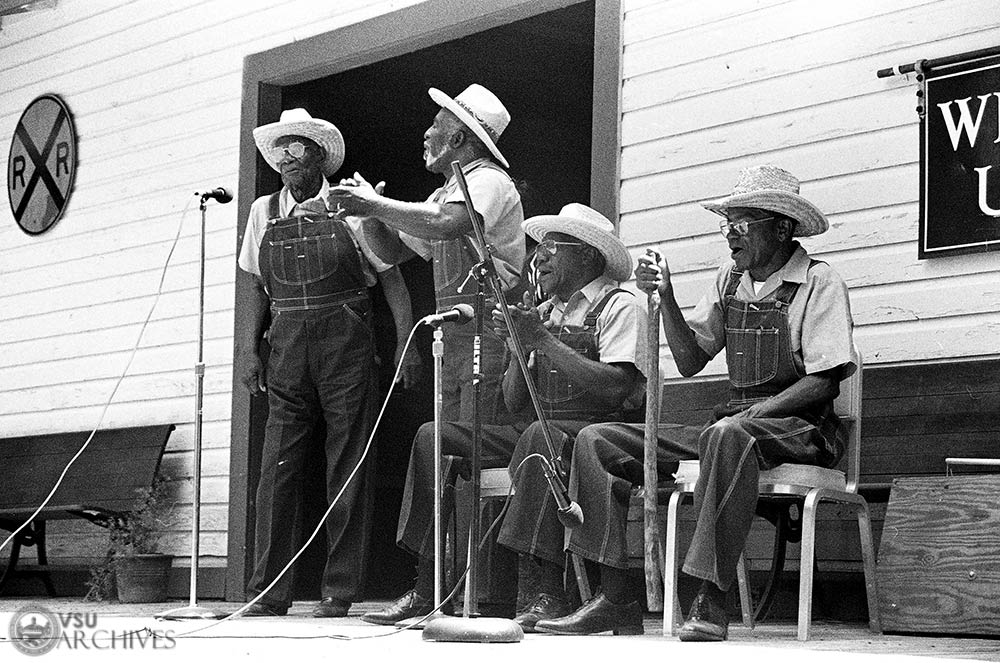
New Taylor Singers
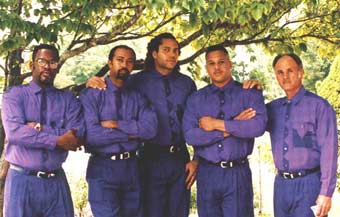
African American gospel from a family of former turpentiners based in Blackshear and Patterson, Georgia. For more information and sound clips click here.
"Faces" in the Piney Woods
Traditions of Turpentine Project
Interviews
If you would like to access these recorded sessions please follow the links and submit a request via ArchivesSpace or contact us.
Brockinton Wetherington, Patricia
2003. Interviewed by Laurie Sommers. Tape Recording, 4 September, Fargo, Georgia. South Georgia Folklife Project, Valdosta State University. Download Audio Recording - Download Transcript
Carter, Gillis
2003. Interviewed by Tim Prizer. Tape Recording, 2 November, Willacoochee, Georgia. South Georgia Folklife Project, Valdosta State University. Download Audio Recording - Download Tape Log and Transcript
Green, Anthrom
2004 Interviewed by LeRoy Henderson. Tape Recording, 19 January, Jacksonville, Florida. South Georgia Folklife Project, Valdosta State University. Download Audio Recording - Download Tape Log and Transcript
Harrington, George
2004. Interviewed by Laurie Sommers. Tape Recording, 10 February, Valdosta, Georgia. South Georgia Folklife Project, Valdosta State University.
Johnson, Wilburt
2004 Interviewed by Tim Prizer. Tape Recording, 21 February, Willacoochee, Georgia. South Georgia Folklife Project, Valdosta State University. Download Audio Recording - Download Tape Log and Transcript
Music, George Jr.
2002 Interviewed by Tim Prizer. Tape Recording, 12 July, Waycross, Georgia. Georgia Folklife Project, Valdosta State University. Download Audio Recording - Download Tape Log and Transcript
Nelson, L.A. "Stick"
2003 Interviewed by Le Roy Henderson. Tape Recording, 10/15/24 July, 7 August, Nashville, Georgia. South Georgia Folklife Project, Valdosta State University. Download Audio Recording - Download Tape Log and Transcript
Phillips, Major
2004 Interviewed by Le Roy Henderson. Tape Recording, 25 January, Adrian, Georgia. South Georgia Folklife Project, Valdosta State University. Download Audio Recording - Download Tape Log and Transcript
Taylor Brothers
1999 Interviewed by Tim Prizer. Tape Recording, September 12, Blackshear, Georgia. South Georgia Folklife Project, Valdosta State University. Download Tape Log and Transcript
Taylor, C. J.
2002 Interviewed by Tim Prizer. Tape Recording, 14 July, Blackshear, Georgia. South Georgia Folklife Project, Valdosta State University.
Taylor, Junior
2002 Interviewed by Tim Prizer. Tape Recording, 14 July, Blackshear, Georgia. South Georgia Folklife Project, Valdosta State University.
Tomlinson, W. C. "Dub."
2003 Interviewed by Laurie Sommers. Tape recording, 15 July, Statenville, Georgia. South Georgia Folklife Project. Valdosta State University, Valdosta, GA. Download Audio Recording - Download Tape Log and Transcript
West, Elliott and Eddie Lee Scipp
2003 Interviewed by Tim Prizer. Tape Recording, 15 July, Folkston, Georgia. South Georgia Folklife Project, Valdosta State University. Download Audio Recording - Download Tape Log and Transcript
White, Willie
2003 Interviews by Tim Prizer. Tape Recordings, 6 July and 15 July, Hoboken, Georgia. South Georgia Folklife Project, Valdosta State University. Download Audio Recording July 6, 2003 - Download Audio Recording July 15, 2003 - Download Tape Log and Transcript
Bernice and J.F. Wilcox
2004 Interviewed by Tim Prizer. Tape Recording, 28 January, Ludowici, Georgia. South Georgia Folklife Project, Valdosta State University. Download Audio Recording - Download Tape Log and Transcript
Wilkerson, Ralph
2004 Interviewed by Tim Prizer. Tape Recording, 22 February, Hoboken, Georgia. South Georgia Folklife Project, Valdosta State University. Download Audio Recording - Download Tape Log and Transcript
"Faces" in the Piney Woods Techniques
Techniques: Working in the Woods
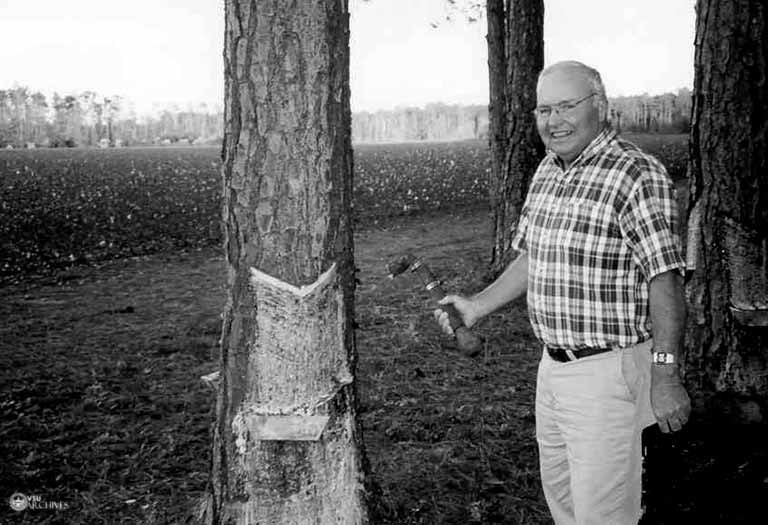
Gillis Carter of Willacoochee works four trees in his front yard as a reminder that turpentine once played such a central role in his family and in the region:
"I reckon, next to my love for the Lord Jesus, I just love turpentining. Not that I know anymore than anybody else about it, but I was raised up in it, and it was my dad's livelihood all of his life. And I just grown a fondness for it, and I just wanted to cut those trees out there and chip 'em for people that passes this highway out here, that they might stop and show it to their kids It's something that I would like to see kept alive 50 years down the road. Because the time has done passed since 1978 [the year Carter and his family ceased to work in the woods as their primary source of income]. We've got a generation of children that's 22 or 24 year old that's never seen a face."
Carter is a self-proclaimed "advocate of the turpentine industry," and part of his current pride in turpentine stems from the fact that he knows how to do nearly everything involved in turpentine labor. Here he demonstrates the processes involved in turpentining:
Faces in the Piney Woods: Tools
Turpentine Tools
Gillis Carter's home place barn outside Willacoochee has a collection of old agricultural tools and pieces of equipment, many of which are specifically from the turpentine industry. The tools of the trade captivate him as much as the trees and the work itself:
I don't know what intrigues me so much about shovels and hoes and axes, but I can't go by one without buying it at an antique market or either picking one up in a junk pile and cleaning it up and putting me a handle in it. I know I'm not gonna be able to swing that axe right on, but I like to have several of 'em anyhow. But I've just enjoyed my little collection.
In the following video clips Carter talks about various tools in his collection.
Turpentine Still Firing
This video footage comes from April 10, 2004, during the turpentine still firing at the Georgia Agrirama's annual Spring Folk Life Festival in Tifton. This year the Agrirama was the only site in Georgia to fire an old-style still. The end of the turpentine industry and the difficulty in locating sufficient raw gum caused the other two locations to quit firing. Previously still firings occurred in Portal at the Carter still during the Catface Community Festival, and at Old South Farm Days in Walthourville. All three sites have re-enacted still firings as part of community festivals. These events attract folks who have some connection to turpentining, often triggering exchange of stories and reminiscences. Typically there is a queen and court who preside over the festivities. At the Agrirama, Miss Tift County Forestry Queen lit the fire to start the stilling process. Turpentiner Arthur Riley of Milan, Georgia provided four barrels of raw gum for the 2004 firing. This gum was two years old at the time, and the resultant grade of rosin was low.
The still at the Agrirama is a fire still from the 1890s period which was moved and reassembled at the Agrirama. This still is actually a composite with parts donated by several different individuals. Georgia led in production of naval stores from 1880-1905 when this type of still was widespread throughout the counties of South Georgia and North Florida. It is a simple copper kettle set in brickwork with a single chimney. In order to charge it, you remove the kettle cap and put in the gum. This part of the process had already taken place when the project team began to videotape.
Pictured in the footage are Agrirama stiller David King, who learned the skill from watching and working with veteran South Georgia stillers; Agrirama curator John Johnson; volunteer George Varn, Jr. whose family has been involved in South Georgia naval stores since just after the Civil War; volunteer Roy Rankin; and volunteer Houston Jackson. Narration is by John Johnson for Programs 1-4, and by David King for Programs 5 and 6. The segments were edited by Bill Muntz.
Introduction: What are fire stills? (from Turpentine Stills by Tony Page, 1998-2002, Georgia Forestry Commission, Used with permission. http://www.gaforests.com/LowerCoastalPlain/interesting/turpentinestill2.php)
Faces In The Piney Woods Guide To Virtual Exhibits
Folklife of Wiregrass Georgia traveling exhibit, curated by Dr. Laurie Kay Sommers, Director, South Georgia Folklife Project, and funded by the National Endowment for the Arts and the Georgia Humanities Council. "Folklife of the Georgia Wiregrass" is a photographic exhibit interpreting the traditional agricultural, religious, and community life of the Wiregrass region of South Georgia. Early European settlers called this distinctive area "Wiregrass County" after the lush native grass that grew beneath stands of longleaf pine. For a PDF file of the panel which mentions turpentining, click here.
Still Firing Process at the Georgia Agrirama Folk Life Festival (Tifton), April 10, 2004. See a video tour of the techniques of firing a turpentine still.
Techniques in the Woods with Gillis Carter of Willacoochee, Georgia, retired turpentiner, video filmed in June, 2004, in the front yard of the Carter home.
Tools of the Turpentiner, with retired turpentiner Gillis Carter of Willacoochee narrating his personal collection housed in his barn.
The Last Barrel
For an article titled "The End of an Era, Georgia Turpentine Industry Fades into History" (Georgia Forestry Magazine Spring 2003: 4-7) staff photographer Bill Godfrey took this series of photos on the last barrels of domestic turpentine being dipped by Major Phillips, an employee of Jim Gillis of Soperton Naval Stores, in August, 2001. This was the last commercial turpentine dipped not only in Georgia, but in the entire U.S. Used with permission
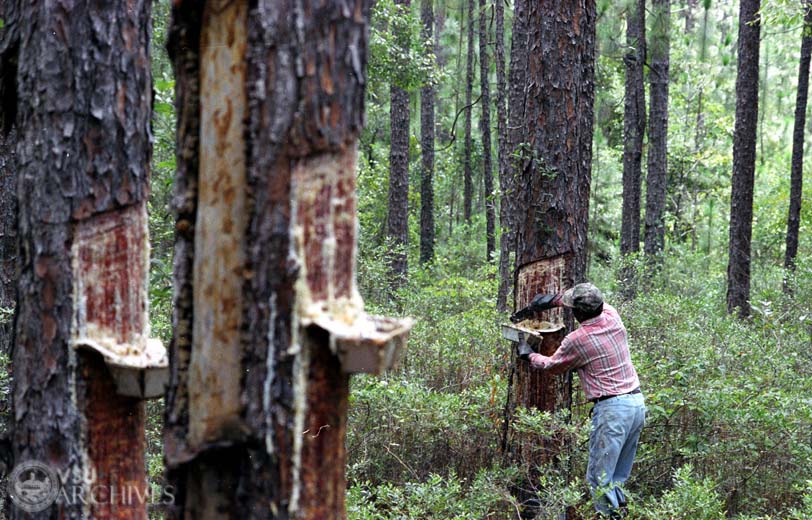
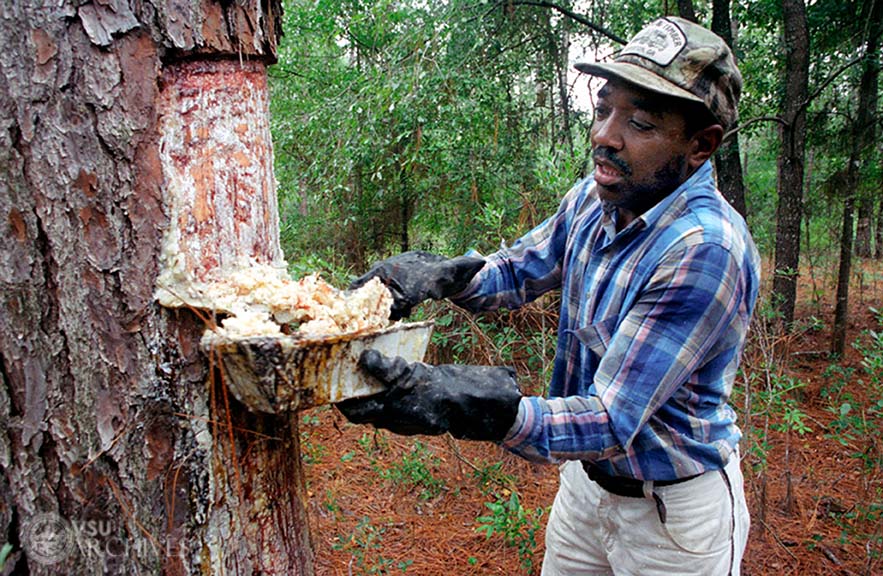
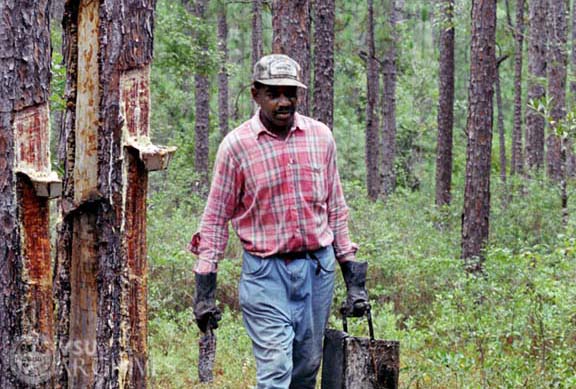
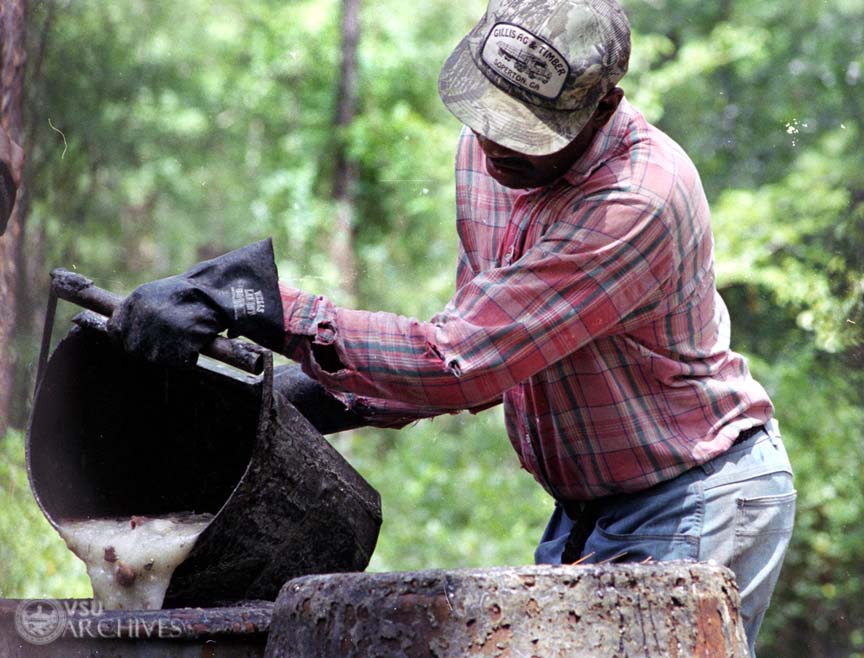
Turpentine Stills
About Us
Faces of the Piney Woods: Traditions of Turpentining in South Georgia is a project of the South Georgia Folklife Project at Valdosta State University. Team members include Dr. Laurie Sommers, project director; fieldworkers Tim Prizer and LeRoy Henderson; videographer Bill Muntz; and web designer Paul Flowers.
About Valdosta State University and the South Georgia Folklife Project
As one of two regional universities within the University System of Georgia, Valdosta State University takes a leadership role in meeting the educational needs of a 41-county region in South Georgia through teaching, service, and research. The VSU service area encompasses an underserved rural population characterized by longstanding British American, German American, and African American populations, small bands of Cherokee and Creek, an emergent but growing Hispanic population, and smaller pockets of other ethnic groups. It is home to the distinctive traditional arts of the Okefenokee, the Wiregrass, and the southern tier of Sea Islands. Since 1998, the College of the Arts has housed the South Georgia Folklife Project (SGFP) through a grant from the NEA Folk and Traditional Arts Infrastructure Initiative. The SGFP has helped to expand audiences for the arts in South Georgia to include a wider range of artists, ethnic groups, and income levels than is customarily served by arts programs within the College of the Arts. The SGFP seeks to provide technical assistance to artists and arts organizations, promote heritage and preservation of traditional arts through documentation and programming, and increase access to traditional arts.
About Dr. Laurie Kay Sommers
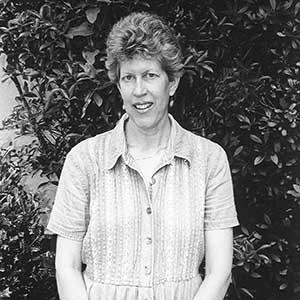
Folklife Project at Valdosta State University, served as folklorist and project director for Faces of the Piney Woods. She supervised all phases of the project. She also conducted interviews with W.C. "Dub" Tomlinson and Patricia Wetherington Brockinton specifically for this project, in addition to earlier interviews with Elliott West, Alton Carter, Junior Taylor, and Clarence Taylor. Sommers founded the South Georgia Folklife Project in 1996. She holds a Ph.D. in Folklore from Indiana University and has worked as a public sector folklorist since 1982 for organizations such as the Indiana Division of State Parks, the Bureau of Florida Folklife, the Smithsonian Office of Folklife Programs, and the Michigan State University Museum. Sommers is author of publications for academic and general audiences and has produced a variety of public programs. An experienced fieldworker, she frequently gives workshops on community documentation. Recent fieldwork with occupational folklife includes interviews with migrant and seasonal agricultural workers in Apopka, Florida (1998), fieldwork with musical ensembles in Michigan auto plants (1997), and work on Georgia turpentining (1998-2004). She currently has an introduction to the work of folklorist Ivan Walton in press with Wayne State University Press as part of Songquest, compiled by Joe Grimm, an indexed volume of excerpts from Walton's field journals on sailor lore of the nineteenth and early twentieth century Great Lakes. Sommers has considerable experience in directing field studies, including her role as research coordinator for fieldwork in preparation for the annual Festival of Michigan Folklife at the Michigan State University Museum (1988-1995), and as instructor of record for three directed studies on local folklife since coming to VSU in 1995. In the summer of 2002 she directed Tim Prizer's volunteer field project on turpentining and has continued in a supervisory role in the present project.
About Timothy C. Prizer

Timothy Prizer worked on the Faces of the Piney Woods project over a three-year period, first as a fieldwork intern and then as primary project fieldworker under the Georgia Folklife Program grant. In the summer of 2002, he completed a volunteer fieldwork project on South Georgia turpentiners with Dr. Laurie Sommers for the South Georgia Folklife Project. This initial research formed the groundwork for the present survey and earned Prizer the American Folklore Society's Archie Green Student Travel Award in 2003. He graduated from Georgia Southern University in December of 2003 with a B. A. in Anthropology and American Studies. In Statesboro, he studied with Dr. Robert Shanafelt, Dr. Barbara Hendry, and the late Dr. Richard Persico, among others, and he has served as an assistant to Dr. Del Presley. In August of 2004, Prizer begins his Master's coursework in the Curriculum in Folklore at the University of North Carolina at Chapel Hill. He plans to further investigate the folk culture of the turpentine industry as a graduate student.
About LeRoy Henderson

LeRoy Henderson served as fieldworker for the project, conducting interviews with L.A. Nelson, Anthrom Green, and Major Phillips. Henderson has worked in cultural arts and the broadcasting industry for over twenty years, much of the time based in Chattanooga, Tennessee. He worked for the African American History Museum in Chattanooga, scripting and narrating two historical documentaries: "Story of a People" and the award winning "Story of Ancient Africa." An experienced interviewer and talk show host for both radio and television, he has done countless interviews, including conversations with such well-known figures as Bishop Desmond Tutu, Coretta Scott King, and Al Gore. Henderson served as news anchor, producer, and Community Affairs Director for WDEF (CBS) Television, Chattanooga. He is also an actor, founder of The Heritage Repertory Theater Company of Chattanooga, and founding member and marketing director of the Beale Street Repertory Theater Company in Memphis.
About Bill Muntz

Interim Director of Public Services, Valdosta State University, served as videographer and video editor for the project. He has over thirty years of active experience in video production including instructional programs, informational programs, spots, lectures, panels, demonstrations, talk shows, music programs, sports, documentary and stage shows. These include individual productions and several series. Muntz has served as producer, director, editor, cameraperson and crew on hundreds of productions using skills in studio production, multi-camera field production, single-camera production, audio recording, lighting, electronic graphics and editing. He has consulted on several other video projects of the South Georgia Folklife Project, in addition to Faces of the Piney Woods.
About Paul Flowers

Paul Flowers served as web designer for the project as part of his internship for a Masters' degree in Computer- Technology Applications at Valdosta State University. A native of Belize and an avid sports enthusiast, he has traveled internationally with the Belize basketball national team as a journalist, an executive, and as director of public relations. Paul Flowers owns and manages the official website and magazine of the only professional basketball league in Belize, and the official website of the Belize City Games. An accomplished musician, Flowers served as public relations manager, marketing director, and lead guitarist for the local and internationally recorded gospel music organization - D-Revelation Ministries. He has fifteen years of experience as a high school teacher, which included stints as Head of Math, Science and Sports departments, and seven years as computer administrator at Gwen Lizarraga High School in Belize City. He also served as counselor at the high school level for eight years, working with at-risk students involved in gang-related activities. In the fall of 2004, he will attend Florida State University to complete a PhD in Technology Training and work as a US Navy research assistant.
